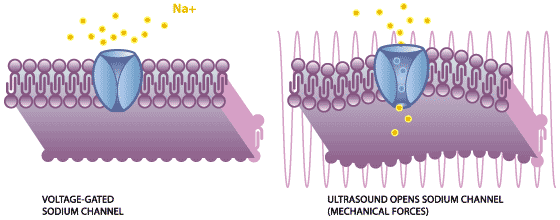
When most people hear the word ultrasound, they think
of the diagnostic tool used to look inside the womb and
steal glimpses at a fetus. But researchers at Arizona
State University at Tempe have developed a new use for
it: to control brain activity from outside the skull.
William J. Tyler, one of the technique’s developers
and an assistant professor at ASU, says ultrasound will
someday allow physicians to substitute neural implants
with external devices. “We’re trying to develop the
technology to the point where we can do away with the
electrodes that are used in vagus nerve stimulation and
deep brain stimulation,” says Tyler.
Vagus nerve stimulation is used to treat epilepsy and
severe depression; deep brain stimulation treats
Parkinson’s disease and, experimentally, other neural
and psychiatric ailments. Both rely on pacemaker-like
systems surgically implanted in a patient’s chest, with
electrodes running either to nerves or the brain.
Eliminating the risks of surgery could make
neurostimulation more widely available.
In October, Tyler and his colleagues reported that
they had used low-power, low-frequency ultrasound to
stimulate activity in thin slices of brain tissue
preserved on slides; by early November, the team had
performed an experiment on a live mouse in which they
induced involuntary movement by stimulating certain
regions of the mouse’s brain from outside its head. In
both cases, they used bursts of ultrasound at
frequencies between 0.44 and 0.67 megahertz—much lower
than the frequencies used in imaging. The device
delivers 23 milliwatts per square centimeter of
brain—a fraction of the roughly 180 mW/cm2 upper limit
established by the U.S. Food and Drug Administration
(FDA) for womb-scanning sonograms.

This combination of low frequencies and low power
represents a sweet spot where the sound readily
penetrates the skull and affects brain cells. The sound
waves temporarily knock open the cells’ voltage-gated
sodium channels, special proteins that allow sodium ions
to pass through the cells’ membranes. The result is a
localized change in a cell’s polarity from negative to
positive. The polarity change can be strong enough to
cause the cell to release chemical neurotransmitters and
thereby induce similar voltage changes in other neurons
to which they are linked, resulting in movement or other
behaviors.

Expectant mothers needn’t worry that ultrasound
imaging would harm fetal brains, says Tyler. His group
has shown that at the higher frequencies and power
ratings used for imaging, ultrasound’s bone-penetrating
and brain-modulating potential is greatly diminished.
Tyler reports that he and his colleagues are also
investigating low-power, low-frequency ultrasound’s use
in another device: instead of triggering precisely
controlled brain activity in a focused area, it would
lower the metabolic rate across the entire brain. One
application for this is the prevention of secondary
damage that occurs in the minutes or hours after a head
injury—when a trauma-induced slowdown of blood flow and
a cascade of biochemical reactions result in cell death.
“Imagine an infantryman rocked by an explosion or a
football player knocked to the ground by a
helmet-to-helmet hit,” says Tyler. “Some sensor would
detect that there was enough force generated for it to
be a concussive event. Then an array of ultrasound
transducers mounted in the helmet would automatically
turn on, modulating neuroprotective pathways in the
brain that would slow the brain’s metabolic rate, [limit
the destructive chemical cascade], and prevent cell
death.”
The low frequencies used can travel some distance
through the air. So could you be zapped with a
mood-altering blast from across a room? Probably not,
Tyler says. In theory, the ultrasound technique could
work from up to about a meter away, he says. “The
farthest we’ve tried so far has been roughly 50
millimeters.”
It will take at least five years for any version of
remote ultrasound brain control to make it through
development, clinical trials, and FDA approval, Tyler
estimates. He says he is establishing a spin-off company
that will do the further research required to get a
device to market. “I feel like I have the social
responsibility to try to develop this as much as
possible,” he says.
see research article:
Remote Excitation of Neuronal Circuits Using Low-Intensity, Low-Frequency
Ultrasound
Synsonix: Ultrasonic Neuromodulation Technology